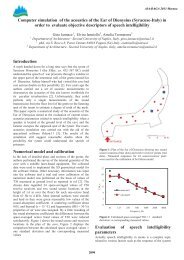Download - Odeon
Download - Odeon
Download - Odeon
You also want an ePaper? Increase the reach of your titles
YUMPU automatically turns print PDFs into web optimized ePapers that Google loves.
Scattering coefficient<br />
S s Surface scattering<br />
Surface scattering is in the following<br />
assumed to be scattering appearing due<br />
to random surface roughness. This type<br />
of scattering gives rise to scattering<br />
which increase with frequency. In Figure<br />
4 typical frequency functions are shown.<br />
In ODEON these functions are used in the<br />
following way: Specify scattering<br />
coefficients for the middle frequency<br />
around 700 Hz (average of 500 – 1000<br />
Hz bands) in the materials list, then<br />
ODEON expands these coefficients into<br />
values for each octave band, using<br />
interpolation or extrapolation.<br />
1<br />
0,9<br />
0,8<br />
0,7<br />
0,6<br />
0,5<br />
0,4<br />
0,3<br />
0,2<br />
0,1<br />
0<br />
Set of scattering coefficients<br />
63 125 250 500 1000 2000 4000 8000<br />
Frequency (Hz)<br />
0.015<br />
0.06<br />
0.25<br />
0.55<br />
0.8<br />
0.9<br />
Figure 6-3: Frequency functions for materials<br />
with different surface roughness. The legend of<br />
each scattering coefficient curve denotes the<br />
scattering coefficient at 707 Hz.<br />
At present it has not been investigated in depth which scattering coefficient (at the midfrequency<br />
707 Hz) should be used for various materials. However initial investigations indicate<br />
that the following magnitudes may be sound.<br />
Material<br />
Scattering coefficient at mid-frequency<br />
Audience area 0.6–0.7<br />
Rough building structures, 0.3–0.5 m deep 0.4–0.5<br />
Bookshelf, with some books 0.3<br />
Brickwork with open joints 0.1–0.2<br />
Brickwork, filled joints but not plastered 0.05–0.1<br />
Smooth surfaces, general 0.02–0.05<br />
Smooth painted concrete 0.005–0.02<br />
Table 1. Suggested scattering coefficients to use for various materials. The given values are for the middle<br />
frequency at around 700 Hz to be assigned to surfaces in ODEON. Suggestions may be subject to changes as<br />
more knowledge on the subject is obtained.<br />
sd<br />
Scattering due to diffraction<br />
In order to estimate scattering due to diffraction, reflector theory is applied. The main theory<br />
is presented in (Rindel, 1986; Rindel, 1992). The goal in these papers was to estimate the<br />
specular contribution of a reflector with a limited area; given the basic dimensions of the<br />
surface, angle of incidence, incident and reflected path-lengths. Given the fraction of the<br />
energy which is reflected specularily we can however also describe the fraction s d which has<br />
been scattered due to diffraction. A short summary of the method is as follows: For a panel<br />
with the dimensions l∙w; above the upper limiting frequency f w (defined by the short<br />
dimension of the panel) the frequency response can be simplified to be flat, i.e. that of an<br />
infinitely large panel, below f w the response will fall off with by 3 dB per octave. Below the<br />
second limiting frequency f l , an additional 3 dB per octave is added resulting in a fall off by 6<br />
dB per octave. In the special case of a quadratic surface there will only be one limiting<br />
frequency below which the specular component will fall off by 6 dB per octave. The attenuation<br />
factors K l and K w are estimates to the fraction of energy which is reflected specularily. These<br />
factors takes into account the incident and reflected path lengths (for ray-tracing we have to<br />
assume that reflected equals incident path length), angle of incidence and distance for<br />
reflection point to the closest edge on the surface all information which is not available before<br />
the calculation takes place.<br />
6-74

















